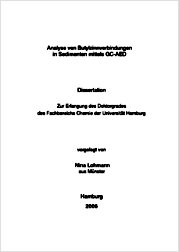| dc.contributor.author | Lohmann, Nina | |
| dc.date.accessioned | 2010-10-12T19:28:37Z | |
| dc.date.available | 2010-10-12T19:28:37Z | |
| dc.date.issued | 2007 | |
| dc.identifier.uri | http://hdl.handle.net/11858/00-1735-0000-0001-31C1-E | |
| dc.description.abstract | Organotin compounds are variously used industrial chemicals. One of the most toxicological relevant compounds is tributyltin (TBT). TBT has been used as an effective component in antifouling paints for decades. Thus, it is set free into the water column in considerable amounts and affects also non-target organismens in very low concentrations. Molluscs like snails and mussels are particularly sensitive and reproduction can be influenced significantly thereby. Once released into the water column, TBT accumulates in sediments and will remain there beyond years due to its high persistence. Several guideline values, target levels and quality standards were specified for TBT, its degradation products monobutyltin (MBT) and dibutyltin (DBT) as well as for other organotin compounds in sediments... | |
| dc.format.extent | 214 S. | |
| dc.format.mimetype | application/pdf | |
| dc.language.iso | deu | |
| dc.publisher | Univ. Hamburg | |
| dc.rights.uri | http://e-docs.geo-leo.de/rights | |
| dc.subject.ddc | 551.9 | |
| dc.subject.gok | VJF 000 | |
| dc.title | Analyse von Butylzinnverbindungen in Sedimenten mittels GC-AED | |
| dc.type | monograph | |
| dc.subject.gokverbal | Umweltgeochemie insgesamt | |
| dc.identifier.doi | 10.23689/fidgeo-310 | |
| dc.identifier.ppn | 558292860 | |
| dc.identifier.urn | urn:nbn:de:gbv:18-33820 | |
| dc.type.version | publishedVersion | |
| dc.relation.collection | Geophysik | |
| dc.description.type | thesis | |


